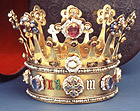A Celebration of Gothic
A new exhibition at the V&A challenges the perception that art in late medieval England played a secondary role to civil and religious warfare. Though many of the treasures were destroyed, a tour round the exhibition reveals that the era produced some of the finest art and artefacts ever made.


A demure golden crown, studded with twinkling jewels of Smartie-sized proportions and encased in glass, proudly taking centre stage, greets the visitor to the V&A's latest exhibition: Gothic, Art for England 1400-1547. Quiet lighting, resplendent walls of deepest blue and notes of medieval songs set a sturdy scene of wealth, triumph and pride.
This artful introduction to the exhibition, the successor to the Age of Chivalry which was held at the Royal Academy in 1988, deliberately aims to shred the commonly held perception that England, during the late medieval period, was a strife-torn country, so obsessed with dynastic war that leading patrons had little time for the arts. Against a backdrop of Agincourt, war with France and the Wars of the Roses, the truth that this exhibition sets out to underline, is that the huge wealth and extensive patronage of monarchs, aristocrats, the Church and merchants ensured that the late medieval years became one of the richest periods for the arts in England.
This was an age of a burgeoning sense of English national identity: the use of the vernacular in English literature was increasingly a feature at the end of a period which saw the publication of the first English bible. It was also an age of conspicuous artistic consumption. As the exhibition's curator, Richard Marks explains: 'The increasing wealth of patrons, both aristocrats and merchants, made rich by textiles and the wool trade, encouraged an outpouring of investment and new commissions of art from throughout England and the Continent. Wealthy patrons were international and cosmopolitan, commissioning the best artists from abroad as well as in England.'
Far from being an 'insular backwater' cut off from the emerging renaissance movements on the continent, England flourished, and art was appreciated regardless of origin: be it English craftsmen, immigrant craftsmen or imported work. 'This is why the exhibition is titled "ArtforEngland", explains Mr Marks. 'France and Flanders were major sources of work but this was also a period of English architecture at its finest, producing such magnificent buildings as King's College Chapel in Cambridge and Henry VIII's palace at Hampton Court.' Demonstrating this interwoven confluence of influences, the exhibition intermingles various mediums, including photographs of buildings, with stained glass windows and even a vast wooden door.
There are some 300 treasures on display, from richly illustrated tapestries, to meticulously engraved manuscripts, gold and silver chalices, tomb effigies and altarpieces. Two 15th century manuscripts, which belonged to the Duke of Bedford, Henry V's brother, have been united for the first time in six centuries. However, even an idle turn through the rooms reveals a certainty that the exhibition cannot disguise: this was a period of immense loss. These objects have not fallen happily together under one roof: they have been painstakingly collated, prised from churches, museums and collections the world over. Civil war, fires and rows over denomination took a heavy toll on art and artefacts from the period, making any surviving pieces extremely rare.
Highlights of the exhibition include an early edition of Chaucer's Canterbury Tales and the Donne Triptych, featuring in seemingly unabashed images of Sir John Donne and his wife in a work devoted to glorifying God, underlining that self promotion, luxury and piety could all go hand in hand in medieval times.
Gothic: Art for England 1400 - 1547is at the Victoria and Albert Museum until January 18, 2004. Tickets (£8 adults, £5 concessions) are available on the door. Or telephone 0870 906 3883 or visitwww.vam.ac.uk.
Sign up for the Country Life Newsletter
Exquisite houses, the beauty of Nature, and how to get the most from your life, straight to your inbox.
Read more:
-
 380 acres and 90 bedrooms on the £25m private island being sold by one of Britain's top music producers
380 acres and 90 bedrooms on the £25m private island being sold by one of Britain's top music producersStormzy, Rihanna and the Rolling Stones are just a part of the story at Osea Island, a dot on the map in the seas off Essex.
By Lotte Brundle
-
 'A delicious chance to step back in time and bask in the best of Britain': An insider's guide to The Season
'A delicious chance to step back in time and bask in the best of Britain': An insider's guide to The SeasonHere's how to navigate this summer's top events in style, from those who know best.
By Madeleine Silver